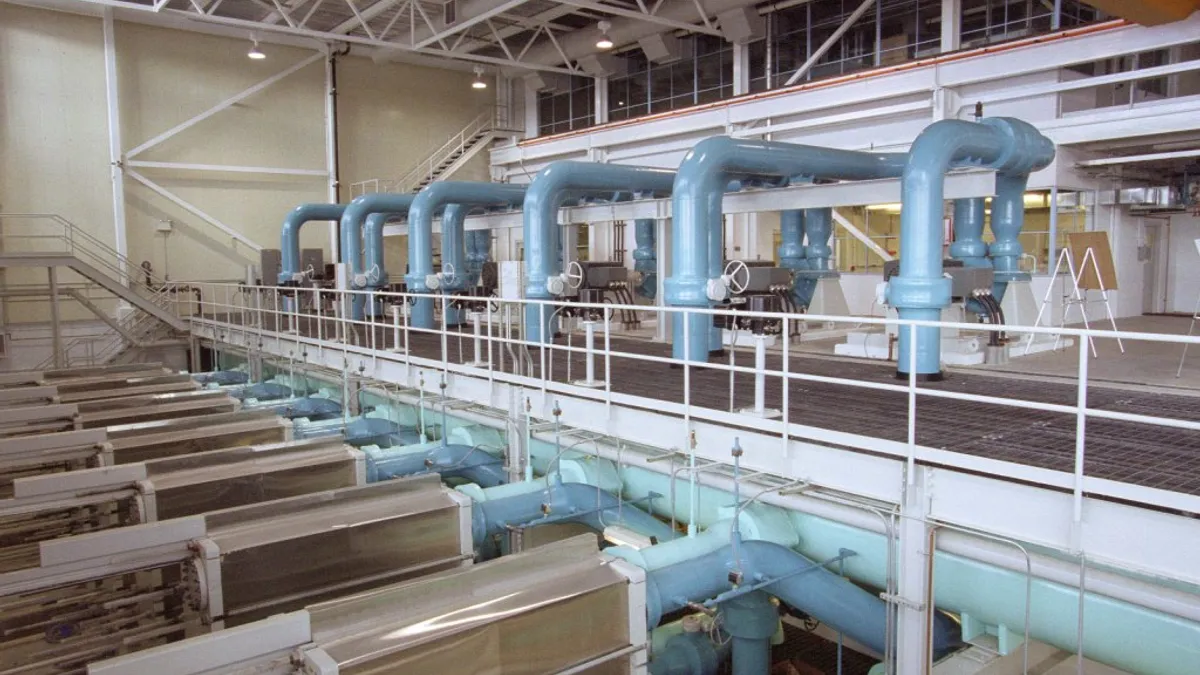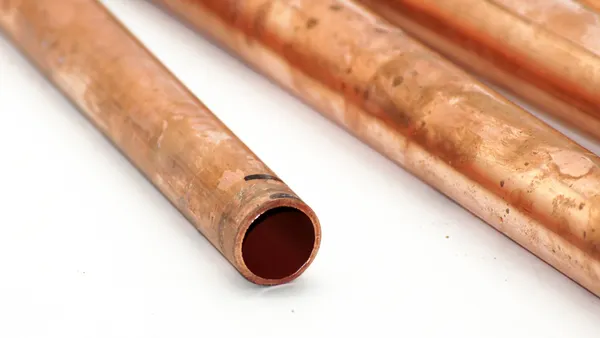Dive Brief:
- Thermal energy networks have the potential to significantly reduce buildings’ water consumption, saving millions of gallons every year, compared with conventional heating and evaporative cooling systems, according to a report from the Building Decarbonization Coalition.
- Eight of the ten sites reviewed by BDC self-reported 337 million gallons of water in collective annual savings, equivalent to the average annual water use of 3,000 U.S. households, according to the report released July 31. While water systems vary depending on system design and the number of connected buildings, these sites showed annual savings ranging from 18% to 46%, or 3,000 to 18,000 gallons per cooling or heating ton, BDC says.
- Given expected increases in water scarcity amid drought and rising cooling demand, the coalition calls for standardized and publicly available water usage data that can help building owners, engineers and operators maximize water savings now. This is especially timely, as thermal energy networks are poised to “expand significantly in the coming years,” driven by federal funding, state legislation and “highly anticipated utility pilot projects in Massachusetts and New York,” BDC says.
Dive Insight:
Heat waves are becoming longer, more intense and more frequent. Data from the U.S. Environmental Protection Agency indicates that the average heat wave season across the 50 large U.S. metropolitan areas analyzed from 1961 to 2023 is about 46 days longer than it was in the 1960s, with heat waves occurring earlier in the spring or even later in the fall.
At the same time, cooling large buildings is water-intensive. As opposed to traditional chillers and cooling tower — which lose water through evaporation and other discharge — thermal energy networks can use a network of underground, water-filled pipes for heat exchange between buildings and energy sources like lakes, rivers, energy-intensive structures, wastewater systems, or even the earth’s stable temperature, says report author Ashley Besic, senior associate of thermal energy networks at BDC.
The systems BDC reviewed as part of its study included lake-source cooling systems; district energy systems that use geothermal sources; district energy systems using chilled and hot water tanks; and a geothermal network with an ambient temperature loop. Participating sites included Cornell University in Ithaca, New York; Colorado Mesa University in Grand Junction, Colorado; Miami University in Oxford, Ohio; Ball State University in Muncie, Indiana; Missouri S&T in Rolla, Missouri; Microsoft’s Redmond campus in Seattle; Nashville Airport in Nashville, Tennessee; Stanford University in Stanford, California; and Enwave Energy Corporation in Toronto.
The study found that Enwave’s thermal energy network, which has 180 connected buildings and 75,000 tons of system cooling capacity, was able to achieve 220 million gallons in annual water savings. The Nashville Airport’s system, consisting of 3,600 tons of heating and cooling capacity across two connected buildings, was able to save 30 million gallons of water in comparison.
Stanford University, which has roughly 1,000 connected buildings, saw 18% in annual water savings, while Miami University expects to achieve savings of 43%, relative to installing a chiller. Stanford University and Miami University were not part of the eight sites that could collectively save about 337 million gallons of water a year, as they did not track direct water savings in gallons in their conversion projects, meaning the total savings for all ten sites would surpass 337 million gallons, the study says.
While the initial numbers are “impressive,” maximizing future water savings requires additional and more consistent reporting and a better understanding of system components and specifications, the report says. To determine how savings can be achieved, BDC recommends that future data collection practices consider three factors — the site’s total water consumption for heating and cooling before installing a TEN or geothermal system; whether these organizations distinguish between water used for cooling and purposes such as sanitation, drinking or irrigation; and whether any cooling towers remain after the geothermal system was installed.
While high installation costs are “sometimes cited as a reason to avoid” thermal energy networks, federal tax credits can help, the report says. For example, converting a water-cooled chiller or any building that uses water-source air conditioners to ground-source heat pumps qualifies the entire HVAC system as geothermal, making it eligible for tax credits, BDC says. These include an investment tax credit of up to 30% under the Inflation Reduction Act, new provisions for carrybacks and credit transfers and the federal Modified Accelerated Cost Recovery System. The MACRS program offers a 10% tax credit and five-year depreciation for commercial geothermal systems, with a 50% bonus depreciation in the first year, according to the report.
For example, a $1 million upgrade to a geothermal system can yield federal tax incentives accounting for $480,000 or 48% of that cost, the report says.












